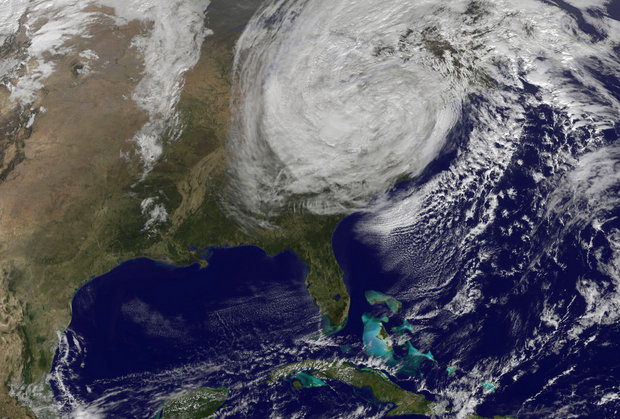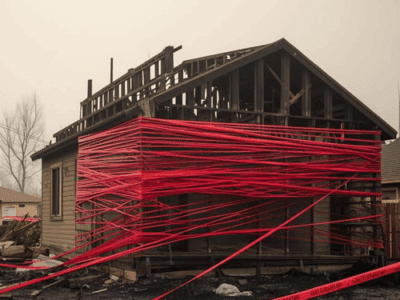Is Hurricane Sandy the Face of Climate Change?
 It’s a question at the forefront of many of our minds, as we witness the aftermath of Sandy’s fierce destruction. In the days following the superstorm, we’ve seen surreal images — an illuminated carousel appearing to float in high water, drowning taxi cabs in perfect rows — things we believed would not happen for decades, as climate change inched up on us slowly and steadily. But climate change does not carry a yardstick; it does not operate in measured units of time and space. It is unpredictable and cumulatively impacted by human activities; a volatile mistress affected by our stubbornness and neglect.
It’s a question at the forefront of many of our minds, as we witness the aftermath of Sandy’s fierce destruction. In the days following the superstorm, we’ve seen surreal images — an illuminated carousel appearing to float in high water, drowning taxi cabs in perfect rows — things we believed would not happen for decades, as climate change inched up on us slowly and steadily. But climate change does not carry a yardstick; it does not operate in measured units of time and space. It is unpredictable and cumulatively impacted by human activities; a volatile mistress affected by our stubbornness and neglect.
And so the question remains, is Sandy the face of climate change? If so, this should serve as a strong signal that without prompt and effective policy measures to address global warming, we are precipitating our own tumultuous future. And perhaps a better question is, shouldn’t we be taking urgent action on climate change regardless of the specific cause of one superstorm?
Temperatures are Rising; Extreme Weather Is Becoming More Extreme
As a non-scientist, I must leave the technical discussion of Sandy’s cause to scientists. However, I will summarize what we know. Extreme events are relatively rare, which means there is little data available to make assessments regarding changes in their frequency or intensity. By contrast, it is easier to chart patterns of global temperature (it is rising), sea level (also rising) and drought (becoming more frequent and severe).
Sandy arrived during one of the warmest years in history in the United States. Sea surface temperatures along the hurricane’s path were about 5°F above historical average temperatures. Hurricanes need warm water to form and sustain their power. In addition to a strong pattern of rising temperatures on land and in the ocean, sea levels have risen. Water levels around New York are a nearly a foot higher than they were 100 years ago. All of this contributes to a nice environment for powerful storms to develop and wreak havoc on our coastal cities and populations.
Extreme weather events are becoming more intense in some regions due to global warming, and will likely continue to be more intense. This is set out in the Fourth Assessment Report of the Intergovernmental Panel on Climate Change (IPCC) as well as in the special report by IPCC Working Groups I and II on Managing the Risks of Extreme Events and Disasters to Advance Climate Change Adaptation (SREX). While the IPCC predicts no increase in the number of cyclone events, it does predict an increase in their severity and intensity – as we saw firsthand with Sandy.
A Risky Wager
 If nothing else, we should pay attention to the massive cost (in dollars and lives) that more powerful storms and hurricanes will have on our population if global temperatures continue to rise. Dozens of U.S. citizens lost their lives due to Sandy, and more than 8 million U.S. homes and businesses lost power, according to the Energy Department estimates. The storm is expected to cause about $20 billion worth of property damage, in addition to $10 billion to $30 billion in lost business. In 2005, Hurricane Katrina cost the Gulf Coast more than $100 billion. It’s hard to ignore the massive financial cost of increasingly lethal storms colliding with development in floodplains and coastal zones.
If nothing else, we should pay attention to the massive cost (in dollars and lives) that more powerful storms and hurricanes will have on our population if global temperatures continue to rise. Dozens of U.S. citizens lost their lives due to Sandy, and more than 8 million U.S. homes and businesses lost power, according to the Energy Department estimates. The storm is expected to cause about $20 billion worth of property damage, in addition to $10 billion to $30 billion in lost business. In 2005, Hurricane Katrina cost the Gulf Coast more than $100 billion. It’s hard to ignore the massive financial cost of increasingly lethal storms colliding with development in floodplains and coastal zones.
In fact, some insurance companies are starting to account for predicted climate impacts such as wildfires, flood risk, and hurricane impacts in their insurance premiums, or are denying coverage altogether for particularly risky areas and activities. Reinsurance companies like Swiss Re and Munich Re have redesigned contracts and are pushing insurers and policymakers to address climate change, as changing weather patterns alter familiar risk and cost structures. (Mills 2007). Earlier this month, Munich Re issued a study entitled “Severe Weather in North America.” It found that the number of “weather-related loss events” has quintupled over the last three decades in North America. While a number of factors contributed to this trend, the report identified global warming as one of the main drivers: “Climate change particularly affects formation of heat-waves, droughts, intense precipitation events, and in the long run most probably also tropical cyclone intensity.”
Perhaps the corporate climate deniers among us should put their money where their mouth is and insure high climate risk areas for lower cost. If they truly believe climate change is a hoax, they should be happy to do so.
Learning from the Disaster
The hope is that Sandy will serve as a wake-up call to mainstream America and mainstream media that global warming is an urgent problem to which we do not currently have solution. Our buildings, roads, levees and people are not indestructible and will be increasingly tested. Unfortunately, we are not winning this battle. And unfortunately, this is not a battle fought only by “all you climate change people,” as CNN moderator Candy Crowley would have you believe – it impacts everyone.
Reader Comments
8 Replies to “Is Hurricane Sandy the Face of Climate Change?”
Comments are closed.







Sandy was also very late in the year for hurricanes, in that part of the world. The latest hurricane on record in the Atlantic; that I have been able to find.
Sandy was also very late in the year for hurricanes, in that part of the world. The latest hurricane on record in the Atlantic; that I have been able to find.
Dear Jayne,
Thanks for writing about hurricane Sandy and global warming. Does anyone know the approximate number of tons of carbon dioxide mitigation that would be necessary in order to prevent such disasters from happening again in the future? Should we stop carbon dioxide emissions at its source and begin to seriously curtail fossil fuel use?
Dear Jayne,
Thanks for writing about hurricane Sandy and global warming. Does anyone know the approximate number of tons of carbon dioxide mitigation that would be necessary in order to prevent such disasters from happening again in the future? Should we stop carbon dioxide emissions at its source and begin to seriously curtail fossil fuel use?
Reblogged this on Standard Climate.
Reblogged this on Standard Climate.